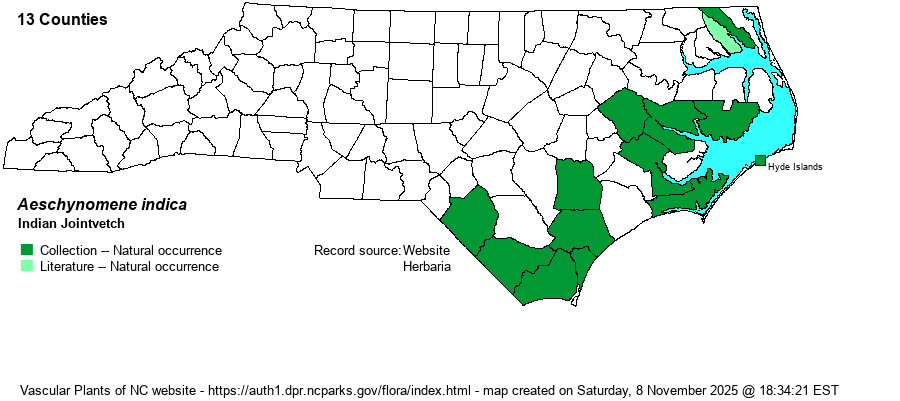| Author | L. | |
| Distribution | Present mostly in the lower half of the Coastal Plain, more frequently close to tidal water, but also inland at least to Pitt, Duplin, and Robeson counties. Recently collected up in Camden County.
This is a species mainly of the tropics, in both the New World and the Old World. Some references consider it not native in the US, but others, including Weakley (2018), suggest it may well be native, ranging north and mostly coastally to eastern NC, and up the Mississippi River to southeastern MO. | |
| Abundance | Uncommon to infrequent, mostly close to tidal water (though a freshwater species); rare more than about 50 miles from the coast. | |
| Habitat | This is a marsh species, of fresh to perhaps slightly brackish water. It often can be found in ditches and other disturbed wetlands, typically in full sun. | |
| Phenology | Blooms from July to October, and fruits a few weeks after flowering. | |
| Identification | This is a fairly robust deciduous herb, which can grow to 2-3 feet tall and at times taller. It is "bushy", with many spreading branches to appear almost like a small shrub. The leaves are even-pinnate, and about 3-4 inches long and 1/4 as wide, with a large number (50-70) of very narrow leaflets; each leaflet is about 1/3-inch long and less than 1/5-inch wide. The small, pale to medium yellow flowers are in a short raceme, mainly in leaf axils but also a few terminal on branches. There is often some purple on each flower at the base. After flowering, the narrow legume grows to 1-2 inches long. The Federally Endangered Virginia Jointvetch (A. virginica) is very similar, and can grow in the same habitats, though it is nearly extirpated in the state. That species has the standard portion of the flower greenish-yellow with distinct dark red veins, whereas A. indica has the standard pale orange or reddish orange, with usually indistinct veins (Weakley 2018). There are a few other technical characters, so if you find a member of this genus, you would do well to perhaps have a key handy in the field. In A. virginica, the flowers are larger, mostly more than 1 cm (0.4-inch) long, whereas in A. indica the flowers are mostly less than 1 cm long. As the other species is so extremely rare now in the state, limited mostly to Hyde and Beaufort counties, if you identify a yellow-flowered legume with about 50 leaflets, you should have this species. To confuse matters even more, there is a non-native species -- A. rudis -- that is becoming more numerous in the Southeast and barely occurs into southeastern NC at the present time. That species has "Paired bracts subtending each flower toothed (rarely entire)", as opposed to "Paired bracts subtending each flower entire (rarely toothed)" (Weakley 2018) in A. indica. | |
| Taxonomic Comments | None. The "jury is still out" whether this species is native in the southeastern US. Wikipedia says "The true native range of this species is unclear because it is thought to have been introduced so widely, but it probably includes parts of Africa, Asia, Australia, and the southeastern United States."
| |
| Other Common Name(s) | Southern Jointvetch | |
| State Rank | S2? [S3] | |
| Global Rank | G5 | |
| State Status | | |
| US Status | | |
| USACE-agcp | FACW link |
| USACE-emp | FACW link |

